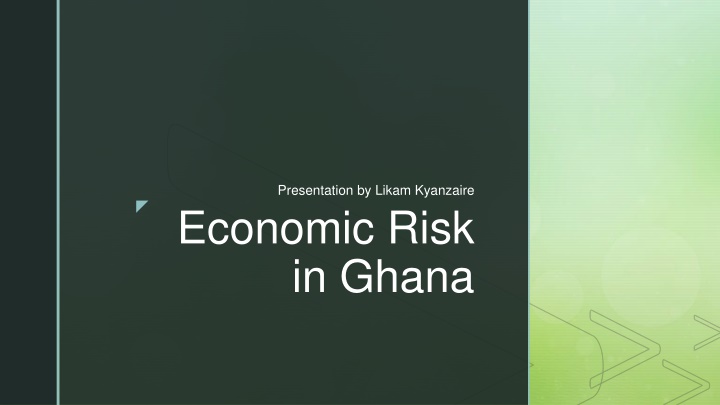
Economic Risk in Ghana
Explore the economic risk factors and history of Ghana, a country with solid social capital and a diverse economy. Learn about the modern development of Ghana, its political-economic framework, and the 21st-century economic landscape characterized by GDP growth, government debt, and sector composition.
Download Presentation

Please find below an Image/Link to download the presentation.
The content on the website is provided AS IS for your information and personal use only. It may not be sold, licensed, or shared on other websites without obtaining consent from the author. If you encounter any issues during the download, it is possible that the publisher has removed the file from their server.
You are allowed to download the files provided on this website for personal or commercial use, subject to the condition that they are used lawfully. All files are the property of their respective owners.
The content on the website is provided AS IS for your information and personal use only. It may not be sold, licensed, or shared on other websites without obtaining consent from the author.
E N D
Presentation Transcript
Presentation by Likam Kyanzaire Economic Risk in Ghana
Economic Risk? These typically refer to features of an economy that increase vulnerabilities to an external shock, or structural fundamentals and policy that can be the basis of home-grown payments crises (Toksoz, The Economist)
Ghana Overview borders Togo, Cote d'Ivoire, and Burkina Faso. It has a population of about 29.6 million (2018). democracy under a multi- party system, with its independent judiciary winning public trust. Ghana consistently ranks in the top three countries in Africa for freedom of speech. Factors such as these provide Ghana with solid social capital (World Bank)
Economic History 13th Century - 1867 1867 - 1957 Asante Empire British colony (Gold Coast) Gold, nuts and slaves Cacao trees from Americas Displacement of local textiles Palm oil, gold
Modern Ghana Liberalized Development (1980s present) National Development (1957 1980s)
Modern Ghana National Development Liberalized Development National independence (1957) Liberazation of economy (early 80s) State led development (1960s) Strucutral Adjustment Programs (1986) Political coup (1966) (1972) (1981) Oil exports (2011)
The 21 Century Economy Growth in GDP from: Commodity supercycle Smart economic policy Government debt from: - New loans from China - Electoral spendings
The Economy Part 2 GDP - composition by sector: agriculture: 18.3% industry: 24.5% services: 57.2% (2017 est.)
Political Economic Framework: Post Keynesian concerned primarily with the depiction of an economic system expanding over time in the context of history investment and savings behavior that this influence of past history and expectations about the future is felt
Political Economic Framework II Macroeconomic disequilibrium: Investment Current Account Working Age Population Productivity
Potential Growth Rate: Working Age Population & Productivity
Issues and Problems Availability of data Overdepence on human capital? Informal sector?
So Whats Good with Ghana? What does can PK predict? How is Ghana doing? What do others say?
The End Questions?
